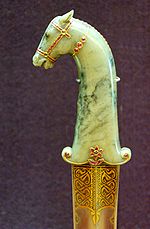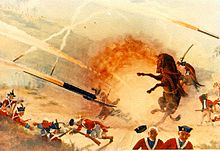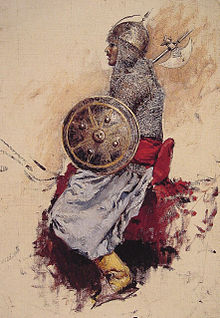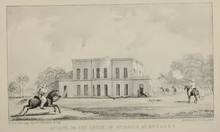- Mughal Army
-
The Mughal Army was the army of the Mughal Empire.
Mirza Najaf Khan was commander in chief of the Mughal Army from 1772 till his death in April 1782.
The art of Mughal warfare brought about a complete change in the way wars were fought in the Indian subcontinent. The Muslim armies that invaded India in the 11th and 12th centuries were small yet the art of their warfare made them invincible. They brought with them techniques and instruments of warfare that were hitherto unheard of in the sub-continent. The soldiers were protected from physical attack by means of a complete shield of armour from head to foot, their daggers and swords were made of superior alloys, and they brought with them the use of gunfire in warfare. That is why despite the courage and valour of the Indian armies a small group of warriors was able to overtake them and lay the foundation for the Mughal Empire.
Contents
Mansabdari System
The Mughal army was interrelated with the Mansabdari system, which was introduced by Akbar. He paid 240 rupees to Manasabdar as salary for every Sawar for a year. But Jahangeer reduced it to 200 rupees. The Emperor paid his own sawars based on their nationality: more to Mugal soldiers than Hindustani Muslims or Rajputs. Munsadar retained 5% of a soldier's salary. These savings were available to them in emergencies. Emperors liked their army to be a mix of Irani, Turani, Mughal, Indian Afghan, and Rajput soldiers, in order to eliminate the differences of tribes and caste. On some special occasions Mughal or Rajput mansabdars allow to recruit their own men.
Recruitment in the Mughal Army
The Mansabdars or high ranking officials of the Mughal administrative system did the process of recruitment for the grand Mughal army. Men from military families who provided their own horses were recruited as cavalrymen. Initially they were mainly Muslim recruits. However as the Empire grew stronger in India, a number of Hindu warriors from the Kshatriya and warring castes were recruited. This is particularly true of the Rajputs in Rajasthan. These Hindu warriors were allowed to train and function under their own respective Kings and Rajahs. The army was divided into infantry, artillery and cavalry of which cavalry was the most important.
Mughal War Outfit
The Mughals had an all-encompassing outfit for war that would secure maximum protection. Every part of the body had a corresponding unit for protection-head, torso and limbs. Discussed below are the various body protection units used by the Mughal warriors.
Armour of mail and plate
A coat made of a combination of mail and plate was worn as body armour. This was known as the Bukhtar. Thick metal acted as a shield against incoming weapons like arrows and lances. This had become popular among the Mongols in the fifteenth century and the Mughals continued its usage right until the Seventeenth century. The coat of mail worn by the ruler and high ranking Amirs reached right up to the knees and was elaborately decorated even with gold bands. Under this was worn a linen or cotton smock which worked as a kind of talisman with writings from the scriptures printed on it. Apart from the Bukhtar, another kind of armour was the Angirkha, where an armour vest was worn under the coat and the Jama was over the Garment to make it in visible. This was usually worn for the protection of the Royal family.
Apart from the mail coat, the cavalry was additionally protected by forearm defences, thigh and knee defences. Arm braces and leg armour of the higher ranks were very expensive, and in the case of the Emperor, the arm braces reached up to the elbows and were lined with velvet.
Shields
Shields were also used for the purpose of protection. This was made out a variety of materials such as cane and bamboo (Pahri), wood and leather (Juna) hides of animals like buffalo and Deer and even crocodile, tortoise and Rhinoceros skin with the last being Forum on History of India a prized possession. Shields known as Sipar were made of iron and steel.
Helmet of Mail and Plate
As headgears, helmets and chain mail were extensively used. This enabled the men to clearly see their enemies while fighting them. Free E-magazine The helmet was fitted like cap and had neck protector attached to it. The Emperor used to wear a helmet made of gold. The helmet typically Mughal outfit which was continued in use by subsequent rulers.
Horse armour of Mail and Plate
Horses were considered as extremely valuable not only as a commodity for import purposes but also due to their extreme importance in warfare. It was on the horses that the warriors were seated and they had to move around the war field on horseback as well. It was therefore of prime importance to protect them from injury. The armour for the horses was made of separate metal pieces that would be fitted on the horse to protect the entire length of its body. A flat metal plate was moulded to fit on their heads to protect their faces from the onslaught of arrows.
The Mughal rulers, in order to ensure superior stock even instituted certain programs for the purpose of breeding horses. Indigenous breeds were found along the river valleys of the Deccan and Kutch (Gujarat). However the best quality horses were those that were brought from Iran via the Hindukush Mountains. Royal horses used in warfare were stamped with the official seal in order to distinguish them from other animals of a lower stock.
Weapons used in Mughal Warfare
The Mughals used various sophisticated weapons for warfare which was the prime reason for their triumph in the sub-continent. A major development in war was made by the introduction of gunpowder in Indian battle, a feat never accomplished before. Among the commonly used weapons are the sword and dagger, guns and cannon, archery and the extensive use of cavalry and infantry during war.
Sword
Talwar with a wootz blade and silver koftigari decoration to hilt and blade forte. The Talwar was the most widely used weapon during Mughal times.
A major change was brought about in the shape and quality of swords since after the advent of the Mughal rule. They brought with them the curved sword, as opposed to the heavy straight swords with rounded ends as was in use at the time. These were sleek, sharp. Curved and made of a superior alloy of iron. The most superior quality blades were imported from Iran and made of crucible steel which gave it a crystalline appearance was capable of cutting deep into the armour and bodies of their adversaries. The ruler always carried with him a sword enclosed in a red sheath. The `Indo-Muslim` hilt, with its typical dish-shaped pommel, seems to have been introduced by the Mughals, and spread throughout India together with the curved-blade, or Talwar. The Mughals and their successors continued to patronize this tradition through royal workshops or Karkhana, and some of the most exquisite items still in existence came from this source
The finest among the swords was considered to be the Shamsher. It was a curved sword with a sharp edge that was primarily used as a cutting weapon. This type of sword was of great value and in fact later went on to become one of the most preferred swords and part of the couture of the Hindu Rajput warriors, called the Khanda.
Daggers (Jamadhar)
Apart from swords, the Muslim armies also used the dagger for purposes of warfare. This was a sharp two-edged instrument that was kept hidden in the boot of the horseman (Khuff).This was used as a secondary weapon.
Archery
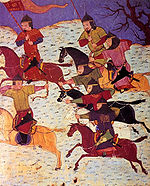 Early Mughal archers used a smaller bow suitable for horse archery.
Early Mughal archers used a smaller bow suitable for horse archery.
The use of bows and arrows, after its skilled usage in the hands of the Central Asian Turks, continued to be practiced by the Mughals. The Bow, typically double- curved, was carried in a container known as the Qirban whereas arrows were carried in quivers called Tarkash. The Mughals were quite skilled in archery and have even been known to poison the tip of the arrows to incapacitate the enemy. Special care was taken even in the manufacturing of these weapons. Bow-makers were sent to special training centres in Damascus and then only the best were allowed to manufacture the same for the purpose of warfare.
Gunpowder and Cannons
The Mughals introduced in India the system of gunfire shot from cannons. This was a very effective ploy in the art of war as apart from the damage on impact, the explosion served to disorient and frighten the horses and elephants. This allowed the cavalry to charge in and prevent the enemies from forming strategies and countering the attack. Cannons, though extremely effective, were quite problematic to transport because of their size and weight. The cannon balls themselves were five hundred forty pounds and the cannon had to be matched accordingly to bear this weight.
From the late fifteenth century there was widespread use of firearms-cannons, muskets and mortars. They were considerably improved and extensively used during the reign of Akbar. In fact the emperor himself had an impressive collection of arms categorized according to weight, make etc. were a large number of musketeers in the Mughal army as muskets tended to overheat and were slow to reload.
other weapons used by the Mughals include maces (Gada), with a dome shaped head and a handle and knob at the end, Piyazi and Garguz shaped like an onion and a flower with eight petals respectively. In order to break the helmet and armour of the enemy soldiers, Shapshar and Amud were used. War axes were great favourites of the infantry as were the Jaghnol-a sharp blade fitted with a spike at the back to pierce through the armour. The tiger claw or Bagh Nakh was another lethal weapon used to disembowel an enemy. This was often used for the purpose of political assassination
Armed with these various weapons of war, the Mughals reigned supreme in the Indian subcontinent as consequent wars and sustained victories led to the growth of a vast Empire. Many of their practices were later taken up and continued by the different Indian rulers, most noted among them the Rajputs.
Types of Mughal army unit
Recruitment in the Mughal Army
The Mansabdars or high ranking officials of the Mughal administrative system did the process of recruitment for the grand Mughal army. Men from military families who provided their own horses were recruited as cavalrymen. Initially they were mainly Muslim recruits. However as the Empire grew stronger in India, a number of Hindu warriors from the Kshatriya and warring castes were recruited. This is particularly true of the Rajputs in Rajasthan. These Hindu warriors were allowed to train and function under their own respective Kings and Rajahs. The army was divided into infantry, artillery and cavalry of which cavalry was the most important.
In Cavalry
Sawar
The word Sowar means 'The one who rides' in Persian, was originally a rank during the Mughal period. The term had been used to define a horse-soldier belonging to the cavalry troops of the Mughal armies in South Asia. It is also used more specifically of a mounted orderly, escort or guard. It was also the rank held by ordinary cavalry troopers, equivalent to Sepoy in the infantry.
Ahadees
Ahadees are household troops of the Mughal emperors. Normally, Munsabdars provides large amount of soldiers. In addition to these soldiers, Emperor also depends on his personal troops. Emperor owned troops are called Ahadees. They are behave like gentlemen. They earn higher amount of salary than normal cavalry soldiers. They are dependable soldiers because of theiy more trusted. They are directly recruited by emperor. They have their own separate duty book. Each soldier maintained Five horses of their own.[1]
Sometimes two Ahadees Maintain only one horse. Their duties are irregular. These type of Ahadees including clerksin Royal offices, Painters in Emperor's Durbar, supervisors in Royal Factories. Many of them are used as Auxiliaries. They carry the Orders of Emperors. In the time of Shajahan, There number is 7000. They Send to the Battlefield regularly. These auxiliary soldiers equally spread all types units as scouts. Some men also worked as artillery, archers.
Zamburak
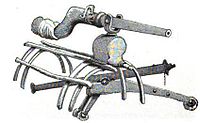 A type of Zamburak which were in use by the Mughal Empire.
A type of Zamburak which were in use by the Mughal Empire.
The Zamburak was a specialized form of camel cavalry and mobile artillery from the Muslim World after the 16th century, consisted of a soldier on a camel with a mounted swivel gun (a small falconet), which was hinged on a metal fork-rest protruding from the saddle of the animal. In order to fire the cannon, the camel would be put on its knees. The name may be derived from Arabic zambūr, hornet (possibly in reference to the sound earlier camel-mounted crossbows made). The mobility of the camel combined with the flexibility and heavy firepower of the swivel gun to make an intimidating military unit.
The soldier type was probably introduced by Egyptian Mamluk warriors who originally mounted large crossbows on the camels, the Zamburak was rapidly adopted by especially by the Persian Safavid armies, the Zamburak was introduced into the Mughal Empire by Mughal Emperor Humayun, Zamburak were used against the invading British in the Anglo-Afghan Wars.
War Elephants
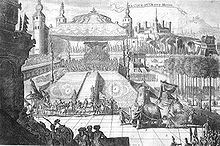 A Mughal parade.
A Mughal parade.
The elephant had a ceremonial and almost power status in the traditional Mughal court. It did have a primary role on the battlefield in early Mughal armies but was supplanted by the faster horse archer. Despite this there were often several thousands, if not tens of thousands of elephants in the Mughal army. The elephant could serve the role of a command platform to keep the general above the crowd of the battle, although it also meant that if the soldiers saw an empty seat on top of an elephant that they may think that the general was dead and flee. l seat Elephants were also kept in the reserve to move in as a very obvious block or counter penetration force if the Mughal battle line was broken. As gunpowder weapons became more prevalent on the Indian battlefield the elephant lost its place even more. It was relegated to being a beast of burden to move weapons and supplies to the front line. It did however maintain the besieging role to pull down fortifications.
The elephant was as much a victim of gunpowder as was the European knight. Unlike the knight however, the elephant did not evolve on the battlefield to a new role but disappeared from the front lines and was pushed further back.
In Infantry
Sepoy
The word sepoy is a disambiguation of the word Persian word Sipahi, the word was commonly used by Mughals and Safavids to describe individual infantry soldiers, the Ottoman Turks used the word to describe the elite Cavalry Sipahi.
The Sipahi were native Mughal musketeer units in the Mughal Empires basic military units, most of them carried Talwars and Sheilds, a special class known as the Atishbaz carried Mughal guns such as Muskets, the Atishbaz served under a Mir Atish (Mir of gunpowder weaponry).
Musketeers in India
Musket warfare became an integral part of Indian warfare when they were introduced to India by the Moghuls in 1519. They were an important defense against the tank-like War Elephants. Both the Mughals and their sworn enemies (such as the Marathas) used musketeers in cover formations while sending volleys of musket fire on unsuspecting soldiers, horses, and elephants.
Mahout
A howdah, or houdah, also known as Hathi Howdah, a carriage which is positioned on the back of an elephant, or occasionally some other animal, used most often in the past to carry wealthy people or for use in hunting or warfare. It was also a symbol of wealth for the owner, and as a result was decorated with expensive gems.
Most notable are the Golden Howdah, used traditionally during the Jamboo Savari (Elephant Procession) of the famous Mysore Dasara. The Museum at Mehrangarh Fort, Jodhpur, Rajasthan has a gallery of royal Howdahs.
Transport
Howdah
A howdah, or houdah, also known as Hathi Howdah, a carriage which is positioned on the back of an elephant, or occasionally some other animal, used most often in the past to carry wealthy people or for use in hunting or warfare. It was also a symbol of wealth for the owner, and as a result was decorated with expensive gems.
Most notable are the Golden Howdah, used traditionally during the Jamboo Savari (Elephant Procession) of the famous Mysore Dasara. The Museum at Mehrangarh Fort, Jodhpur, Rajasthan has a gallery of royal Howdahs.
References
Wikimedia Foundation. 2010.



